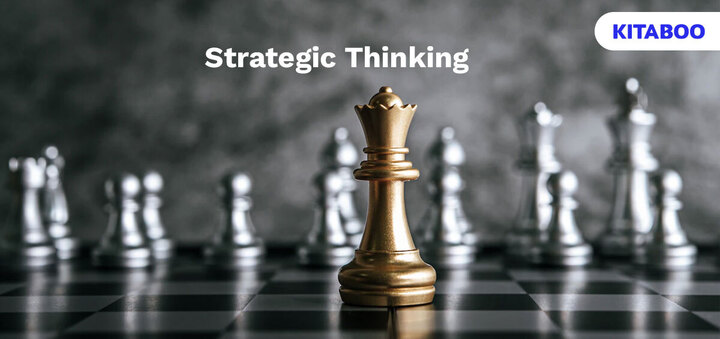
The Power of Strategic Thinking: A CEO’s Guide to Long-Term Success
Leading any business in the 21st century is a more complex journey due to the effects of the digital economy on customer expectations. However, digital transformation is not the only factor impacting leadership decision-making.
In research featuring the world’s top CEOs, leaders share the top trends that are impacting how they lead. The research found that:
- The rise of disruptive digital technologies tops the list at 58%
- Followed by the risk of prolonged high inflation and economic downturn (56%), escalation of geopolitical risks (47%), and war for talent (34%).
- Other factors include shifts in the way we work (30%), the impact of climate change (29%), and an increase in supply chain disruption (14%).
The publishing industry, too, is impacted by these factors, which can adversely impact unprepared businesses. Hence, leaders must be able to predict and plan for a multitude of eventualities.
This is where strategic thinking comes into play. Strategic thinking is a skill that can equip leaders to respond strategically in challenging times.
Table of contents
I. Growing Importance of Strategic Thinking
II. Strategic Thinking Pillars
- Clearly Defining Business Goals
- Inculcating Customer-Centricity
- Adopting A Data-Centric Mindset
- Identifying Opportunities
- Thinking Automation
- Nurturing a Productive Workforce
III. The Conclusion
Growing Importance of Strategic Thinking
Strategic thinking is considered to be an important competency of leaders, enabling them to see the big picture, predict all potential outcomes, and design solutions that are aligned with long-term business goals.
This approach is very different from a tactical approach, where leaders react to situations as they arise with no foresight to anticipate challenges. A tactical approach can work in the short-run, but the consequences of such actions can prove detrimental in the long term unless they are properly thought through.
There are many ways to enhance strategic thinking abilities.
For instance, a survey conducted among 2,586 managers from North America, Europe, Africa, and Asia indicated that any leader aspiring to transition from the “tactical, not strategic” label could do so by enhancing their understanding, allocation of resources, and implementation of business strategies.
Investing in improving one’s strategic thinking skills can help leaders in multiple ways. It helps them develop a long-term vision, foster a culture of innovation, and boost risk management and operational success.
Strategic Thinking Pillars
Let’s review some of the areas in which leaders can apply strategic thinking skills and lead their companies to capture higher market share and be market leaders in their domain.
1. Defining Business Goals
Building a sustainable business that survives through many crises and challenges is a slow, long-term process. Research indicates that the adoption of strategic thinking can enable business leaders to accelerate business growth.
For instance, a survey conducted among 400 small and medium-sized businesses indicated that strategic thinking was helping businesses be more proactive, yet building stability in their business orientation. Leaders need to consistently revisit business plans to ensure that their enterprise is on track to be sustainable, profitable, and aligned with its vision and values.
2. Inculcating Customer-Centricity
Some businesses get so caught up in the digital disruption process that they forget to prioritize the customer. Leaders must cultivate a customer-centric culture that understands the customer’s needs and aspirations at every step of the way.
3. Adopting A Data-Centric Mindset
Today, everyone, from the CEO to the content developer and instructional designer, needs to inculcate a data-centric mindset. But this value needs to percolate from the top.
When leaders attach value to data and invest in data-centric resources, decisions can be based on facts rather than the intuition of a few. Equipping teams with the right tools can be a game-changer.
For instance, when it comes to education, the adoption of cloud-based AI-powered, subscription-based models like KITABOO helps in understanding the behaviors and engagement patterns of K12 learners, predicting future trends, and shaping teaching strategies.
4. Identifying Opportunities
There’s no point catering to customers in an already crowded market space. Instead, businesses must put underserved customers with access to limited products in the market.
Building mobile-first learning products can help deliver courses to 95% of the world’s internet users, who are online via mobile. Building innovative products for untapped audiences can help drive customer acquisition and sales.
5. Thinking Automation
As the world gets more automated, leaders must consider embracing the benefits of automation. This shift helps reduce manual efforts, bring in more efficiency, expedite production cycles, and bring down operational costs.
However, the opportunity is much larger. The adoption of smart tools, which leverage technologies such as Artificial Intelligence (AI), machine learning, and gamification, can enable businesses to offer better quality, cutting-edge, user-friendly, and accessible products that cater to a wider audience.
Rather than developing such tools in-house, companies can access cost-effective subscription-based models and hit the ground running immediately. KITABOO, for instance, offers higher education publishers the flexibility to acquire a licensed version as well as a subscription-based model.
6. Nurturing a Productive Workforce
While paying attention to customers is key, so is the investment in building productive, agile workforces. Nurturing a strong training culture and paving the way for change management can help keep workforces motivated, reduce attrition, and save on hiring costs.
Leaders must strategize on the best workforce management approach that enables them to run with lean, agile, and motivated teams.
Conclusion
Strategic thinking has emerged as one of the top skills that leaders in any business must inculcate as they navigate a wide spectrum of opportunities and challenges. By applying strategic thinking to various key growth areas, leaders can empower their teams to deliver faster business outcomes and become market leaders in their domain.
If your company needs access to superior digital publishing tools, KITABOO is geared with the right technology solutions to support you in your mission. Leverage our cloud-based digital publishing platform, which is available as a licensed version (one-time buy) as well as a subscription-based model.
Get in touch with us to start a conversation.
Also check:
Discover how a mobile-first training platform can help your organization.
KITABOO is a cloud-based platform to create, deliver & track mobile-first interactive training content.


